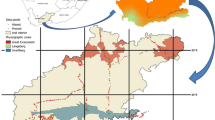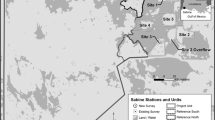Abstract
We developed relationships for estimating wetland condition from remotely sensed data and digital maps. Assessment methods relying on maps rather than field sampling (level 1 assessment) are often expert systems summarizing the best professional judgments of wetland scientists. We instead developed level 1 assessment relationships by statistically analyzing results from field sampling. The field campaign applied the hydrogeomorphic (HGM) functional assessment approach to sample 143 freshwater flat and riverine wetlands in the Nanticoke River watershed, Maryland and Delaware, USA. Functional condition index (FCI) scores for five wetland functions were calculated from the field observations. We used geographic information system (GIS) analysis of digital maps to derive candidate landscape indicators for the sampled points. We tested which indicators correlated strongly with the field condition scores, and then we used stepwise multiple regression and regression tree analysis to identify the most effective combinations of landscape metrics for predicting the condition measurements. The best multiple regressions combined information from land-cover, road, and stream maps, especially a stream map resolving natural stream reaches from channelized or ditched reaches. For riverine wetlands, we obtained statistically significant regressions explaining 63%–85% of the variance of measured FCI scores for all five HGM functions (hydrology, biogeochemistry, habitat, plant community, and landscape). Comparable models for flat wetlands were also statistically significant but explained less (48%–54%) of the variance. Regression tree analysis produced more parsimonious models than did stepwise multiple regression. A tree model explained the same amount of variability as the multiple regression model for two flat and two riverine functions, but the tree model explained less variability for two flat and three riverine functions. Our level 1 relationships can be applied to estimate condition scores for unsampled wetlands and to provide confidence limits for those estimates. The uncertainty in predicting a condition scores for individual assessment points is high for most HGM functions, but the models can still help prioritize field visits to select sites for management action. Confidence limits are narrower for predicting mean scores across many wetlands, so the relationships are more powerful for predicting average wetland condition across an assessment area, such as a watershed.
Similar content being viewed by others
Literature Cited
Abbruzzese, B. and S. G. Leibowitz. 1997. A synoptic approach to assessing cumulative impacts to wetlands. Environmental Management 21: 457–75.
Brinson, M. M. 1993. A hydrogeomorphic classification for wetlands. U.S. Army Corps of Engineers Waterways Experiment Station, Vicksburg, MS, USA. Technical Report WRP-DE-4, NTIS No. AD A270 053.
Brooks, R. P., D. H. Wardrop, and J. A. Bishop. 2004. Assessing wetland condition on a watershed basis in the Mid-Atlantic region using synoptic land cover maps. Environmental Monitoring and Assessment 94: 9–22.
CBP. 2004. Chesapeake Bay Program wetlands assessment: a tool for wetlands identification and planning at the watershed level. Wetlands Workgroup, Living Resources Subcommittee, Chesapeake Bay Program, Annapolis, MD, USA.
DDA. 2003. Green infrastructure of Delaware. Map prepared by Delaware Department of Agriculture available at http:// www.dnrec.state.de.us/nhp/information/17_App_A.pdf.
De’Ath, G. and K. E. Fabricius. 2000. Classification and regression trees: a powerful yet simple technique for ecological data analysis. Ecology 8: 3178–92.
DNREC. 2002. Watershed assessment report (305(b)), Delaware Department of Natural Resources and Environmental Control, Dover, DE, USA.
EPA. 2001. Protecting and restoring America’s watersheds U.S. Environmental Protection Agency, Office of Water, Washington, DC, USA.EPA-840-R-00-001.
EPA. 2002. Streams with Strahler > 2. Data and metadata downloadable from http://www.epa.gov/emap/html/cdrom/ma_atlas/maia_dlg/streams.html.
EPA-EMAP. 1994. Chesapeake Bay watershed pilot project. U.S. Environmental Protection Agency, Environmental Monitoring and Assessment Program, Research Triangle Park, NC, USA. EPA/620/R94/020.
ESRI. 2005. Census 2000 TIGER/line data. Data downloadable from http://www.esri.com/data/download/census2000_tigerline/index.html.
Fennessy, M. S., A. D. Jacobs, and M. E. Kentula. 2004. Review of rapid methods for assessing wetland condition. U.S. Environmental Protection Agency, National Health and Environmental Effects Laboratory, Corvallis, OR, USA. EPA/620/R-04/009.
Findlay, C. S. and J. Bourdages. 2000. Response time of wetland biodiversity to road construction on adjacent lands. Conservation Biology 14: 86–94.
Goetz, S. J., R. K. Wright, A. J. Smith, E. Zinecker, and E. Schaub. 2003. IKONOS imagery for resource management: tree cover, impervious surfaces, and riparian buffer analyses in the mid-Atlantic region. Remote Sensing of the Environment 88: 195–208.
Gordon, N. D., T. A. McMahon, and B. L. Finlayson. 1992. Stream Hydrology. John Wiley & Sons, Inc., New York, NY, USA.
Holm, S. 1979. A simple sequentially rejective multiple test procedure. Scandinavian Journal of Statistics 6: 65–70.
Homer, C., C. Huang, L. Yang, B. Wylie, and M. Coan. 2004. Development of a 2001 national land-cover database for the United States. Photogrammetric Engineering and Remote Sensing 70: 829–40.
Houlahan, J. E. and C. S. Findlay. 2004. Estimating the ‘critical’ distance at which adjacent land-use degrades water and sediment quality. Landscape Ecology 19: 677–90.
Huang, C., L. Yang, B. K. Wylie, and C. G. Homer. 2001. A strategy for estimating tree canopy density using Landsat-7 ETM+ and high resolution images over large areas. p. 230–40. In Proceedings of the third international conference on geospatial information in agriculture and forestry, Denver, CO, USA, 5–7 November, 2001.
Jones, K. B., K. H. Riiters, J. D. Wickham, R. D. Tankersley, R. V. O’Neill, D. J. Chaloud, E. R. Smith, and A. C. Neale. 1997. An ecological assessment of the United States Mid-Atlantic region. U.S. Environmental Protection Agency, Office of Research and Development, Washington, DC, USA. EPA/ 600/R-97/130.
Jordan, T. E., M. A. Pittek, R. P. Szuch, D. F. Whigham, and D. E. Weller. 2007. Comparing rapid functional assessments of wetlands to measurements of soil characteristics and nitrogen processing. Wetlands 27: 479–97.
Lefsky, M. A., W. B. Cohen, G. G. Parker, and D. J. Harding. 2002. Lidar remote sensing for ecosystem studies. Bioscience 52: 19–30.
MD DNR. 2003. Maryland’s green print program. Web site at http://www.dnr.state.md.us/greenways/greenprint/.MDDNR. 2005. DNR wetlands. Metadata available at ftp:// dnrftp.dnr.state.md.us/public/SpatialData/WetlandsDNR/County/ dnrwet.htm.
SAS Institute Inc. 2004. SAS/STAT 9.1 User’s guide. SAS Institute, Inc., Cary, NC, USA.
Snedecor, G. W. and W. G. Cochran. 1980. Statistical Methods, seventh edition. Iowa State University Press, Ames, IA, USA.
Sokal, R. R. and F. J. Rohlf. 1981. Biometry. W. H. Freeman and Co., San Francisco, CA, USA.
State of Delaware. 1994. Procedures Manual: Development of Statewide Digital Orthophotography, Street Centerlines, and Wetlands Mapping. Prepared for the Delaware Dept. of Transportation and DNREC by PhotoScience, Inc., Dewberry & Davis, and Environmental Research, Inc. PhotoScience, Inc., Gaithersburg, MD, USA.
Stevens, D. L., Jr. and S. F. Jensen. 2007. Sampling design, implementation, and analysis for wetland assessment. Wetlands 27: 515–23.
Stevens, D. L., Jr. and A. R. Olsen. 1999. Spatially restricted surveys over time for aquatic resources. Journal of Agricultural, Biological, and Environmental Statistics 4: 415–28.
Stevens, D. L., Jr. and A. R. Olsen. 2000. Spatially-restricted random sampling designs for design-based and model-based estimation. p. 609–16. In Accuracy 2000: Proceedings of the 4th International symposium on spatial accuracy assessment in natural resources and environmental sciences. Delft University Press, Delft, The Netherlands.
Suter, L. A., J. B. Stanfill, D. M. Haupt, C. J. Bruce, and J. E. Wuenscher. 1999. NC-CREWS: North Carolina coastal region evaluation of wetland significance. North Carolina Department of Environmental and Natural Resources, Charlotte, NC, USA.
Therneau, T. M. and E. J. Atkinson. 1997. An introduction to recursive partitioning using the RPART routines. Technical report. Mayo Foundation, Rochester, MN, USA.
Tiner, R. W. 1985. Wetlands of Delaware. U.S. Fish and Wildlife Service, Newton Corner, MA, USA.
Tiner, R. W. 2004. Remotely-sensed indicators for monitoring the general condition of “natural habitat” in watersheds: an application for Delaware’s Nanticoke River watershed. Ecological Indicators 4: 227–43.
Tiner, R. W. 2005. Assessing cumulative loss of wetland functions in the Nanticoke River watershed using enhanced national wetlands inventory data. Wetlands 25: 405–19.
Tiner, R., H. C. Bergquist, J. Q. Swords, and B. J. McClain. 2001. Watershed-based wetland characterization for Delaware’s Nanticoke River watersheds: a preliminary assessment report. National Wetlands Inventory Report. U.S. Fish and Wildlife Service, Northeast Region, Hadley, MA, USA.
Tiner, R. W. and D. B. Burke. 1995. Wetlands of Maryland. U.S. Fish and Wildlife Service, Hadley, MA, USA.
Tiner, R., M. Starr, H. Bergquist, and J. Swords. 2000. Watershed-based wetland characterization for Maryland’s Nanticoke River and Coastal Bays watersheds: a preliminary assessment report. National Wetlands Inventory Report. U.S. Fish and Wildlife Service, Northeast Region, Hadley, MA, USA.
TNC. 1998. Nanticoke River bioreserve strategic plan. The Nature Conservancy, Bethesda, MD, USA.
USACE. 2005. (U.S. Army Corps of Engineers). HGM approach—guidebooks. Bibliography available at http://el.erdc. usace.army.mil/wetlands/guidebooks.html.
USDC. 2001. (U.S. Dept. of Commerce). TIGER/line files, redistricting census 2000. Metadata file at http://www.census. gov/geo/www/tiger/rd_2ktiger/tlrdmeta.txt.
USGS. 1999. (U.S. Geological Survey) National hydrography dataset (NHD) —medium resolution. Metadata file available at http://nhdgeo.usgs.gov/metadata/nhd_medium.htm.
USGS. 2000. (U.S. Geological Survey) The national hydrography dataset concepts and contents. Document available electronically at http://nhd.usgs.gov/chapter1/chp1_data_users_guide.pdf.
USGS. 2004a. (U.S. Geological Survey) National hydrography dataset (NHD) —high-resolution. Metadata file available at http://nhdgeo.usgs.gov/metadata/nhd_high.htm
USGS. 2004b. (U.S. Geological Survey) National land cover database zone 60 land cover layer. Metadata file available at http://www.mrlc.gov.
USGS. 2005. (U.S. Geological Survey) National wetlands inventory. Metadata and data download available at http://wetlandsfws.er.usgs.gov/.
Venables, W. N. and B. D. Ripley. 2002. Modern Applied Statistics with S, fourth edition. Springer, New York, NY, USA.
Vogelmann, J. E., T. Sohl, S. M. Howard, and D. M. Shaw. 1998. Regional land cover characterization using Landsat Thematic Mapper data and ancillary data sources. Environmental Monitoring and Assessment 51: 415–28.
Weber, T. 2003. Maryland’s green infrastructure assessment. Maryland Department of Natural Resources, Annapolis, MD, USA.
Whigham, D. F., A. D. Jacobs, D. E. Weller, T. E. Jordan, M. E. Kentula, S. F. Jensen, and D. L. Stevens, Jr. 2007. Combining HGM and EMAP procedures to assess wetlands at the watershed scale —status of flats and non-tidal riverine wetlands in the Nanticoke River watershed, Delaware and Maryland (USA). Wetlands 27: 462–78.
Whigham, D. F., D. E. Weller, A. D. Jacobs, T. E. Jordan, and M. E. Kentula. 2003. Assessing the ecological condition of wetlands at the catchment scale. Landschap 20: 99–111.
Yang, L., C. Huang, C. G. Homer, B. K. Wylie, and M. J. Coan. 2003. An approach for mapping large-are impervious surfaces: synergistic use of Landsat-7 ETM+ and high spatial resolution imagery. Canadian Journal of Remote Sensing 29: 230–40.
Author information
Authors and Affiliations
Corresponding author
Rights and permissions
About this article
Cite this article
Weller, D.E., Snyder, M.N., Whigham, D.F. et al. Landscape indicators of wetland condition in the Nanticoke River watershed, Maryland and Delaware, USA. Wetlands 27, 498–514 (2007). https://doi.org/10.1672/0277-5212(2007)27[498:LIOWCI]2.0.CO;2
Received:
Accepted:
Issue Date:
DOI: https://doi.org/10.1672/0277-5212(2007)27[498:LIOWCI]2.0.CO;2




